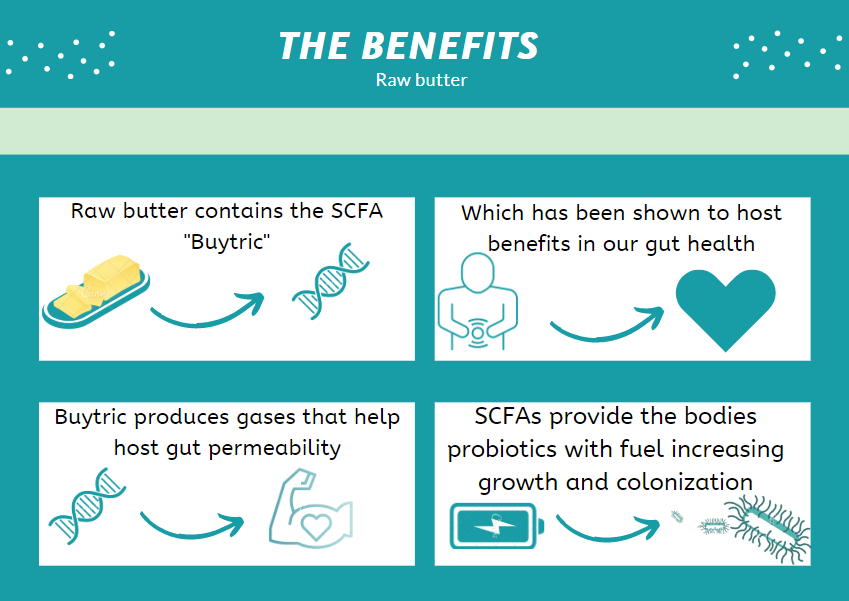Most dairy products we see in stores today have been pasteurized, but what exactly does that mean? Pasteurization is the process in which a substance is heated to eliminate potential pathogens and increase shelf life.
The problem with applying this to dairy products is that it also eliminates beneficial bacteria and destroys enzymes and vitamins. Many of these enzymes destroyed are needed for the body to be able to absorb other key nutrients such as calcium.
Raw butter, which is made using unpasteurized milk, has been used by humans for thousands of years and has numerous reported health benefits despite being illegal in many states due to ill-informed opinions. Our team decided to take a closer look to find out just what the benefits are of responsibly sourced raw butter.
Benefits of Raw Butter
1) Raw butter provides the body with a variety of fat-soluble vitamins
These vitamins include E, D, K, and A, which support good vision, the endocrine system, and general neurological health.
Vitamin A is absorbed by the body easier through raw butter than most other sources. It is needed for thyroid, adrenal, and cardiovascular health. Along with Vitamin D, it is necessary for calcium absorption and the promotion of bone health.
2) Raw Butter Contains a Unique Short-Chain Fatty Acid Known as Butyric Acid
Butyric acid makes up 4% of overall fat.
Butyric acid plays a key role in several biological processes such as immunoregulation, bacterial microflora composition, gastrointestinal tract motility, and it also exhibits strong anti-inflammatory activity.
A study by the Department of Paediatric Gastroenterology and Nutrition at the Medical Institute of Warsaw analyzed the potential benefits of butyric acid in irritable bowel syndrome (IBS), the most commonly diagnosed gastrointestinal condition. In a double-blind, randomized, placebo-controlled study, butyric acid was given to 66 adult patients diagnosed with IBS. After four weeks, researchers noted a statistically significant decrease in abdominal pain during defecation with the butyric acid group.
At twelve weeks, there was also a significant decrease in the frequency of spontaneous abdominal pain in the patients. During the testing period, it was noted that there were no noticeable side effects in the butyric acid group and that they reported a higher quality of life.

3) Raw Butter Can Protect Against Gastrointestinal Infections
Glycosphingolipids, another type of fatty acid found in raw butter, are known to protect against gastrointestinal infections. The various fatty acids butter contains do not need to be emulsified by bile salts because they are easily absorbed from the small intestine and travel directly to the liver. Once there, they are converted into quick energy rather than stored in the fat tissue.
4) Raw Butter Contains Healthy Cholesterol
Despite the negative associations, we actually cannot survive without a certain amount of cholesterol.
- 25% of all body cholesterol is in the brain. Every cell in the brain and the nervous system needs cholesterol. This could indicate a link between prescription statin use (cholesterol-lowering medication) and memory problems – we need cholesterol to think!
- Cholesterol protects us against depression as it plays a role in the utilization of serotonin, the body’s “feel-good” chemical. (Weston A. Price).
- Hormones are made from cholesterol. Without it, we cannot produce testosterone, progesterone, pregnenolone, androsterone, estrone, estradiol, corticosteroids, and aldosterone. Without cholesterol, women would not be able to get pregnant.
- The liver needs cholesterol for bile production to digest and absorb fats.
- Immune cells rely on cholesterol to fight infections and repair the cells.
- Mother’s milk is high in cholesterol because it is necessary for the growth and development of the child.
Why Source Matters
The health benefits of raw butter are directly related to the health and diet of the cow it’s made from.
Reports from the Centers for Disease Control from 2005 to 2016 were compiled and analyzed by the National Institutes of Health. They discovered that the rate of unpasteurized milk-associated outbreaks has been declining since 2010, despite increasing legal distribution. They have stated that “controlling for growth in population and consumption, the outbreak rate has effectively decreased by 74% since 2005.”
Bottom Line
Raw butter has been shown numerous times to provide a variety of health benefits that would be removed during the common pasteurization process.
As more legislation is passed allowing for responsible regulation of unpasteurized dairy products, it becomes easier to distinguish the cleanest sources and provides the public with relief to any danger that otherwise may have been present in raw dairy products.
Sources
Butyric acid in irritable bowel syndrome
https://www.ncbi.nlm.nih.gov/pmc/articles/PMC4027835/
Recent Trends in Unpasteurized Fluid Milk Outbreaks, Legalization, and Consumption in the United States
